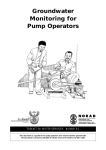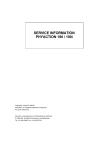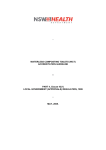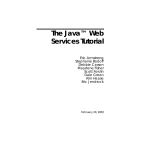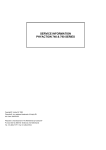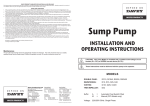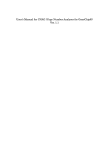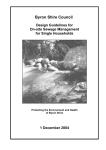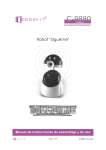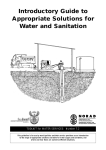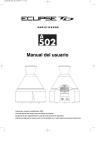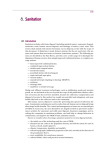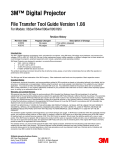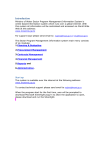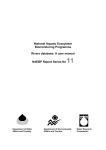Download Guide for protecting boreholes
Transcript
Groundwater Protection Guidelines for Protecting Boreholes and Wells TOOLKIT for WATER SERVICES: Number 3.3 This document is written primarily for Water Services Authorities, Water Services Providers, implementing agencies and Catchment Management Agencies in order to provide guidelines and tools to help protect rural community water supply sources from potential contamination. Groundwater Protection - Guidelines for Protecting Boreholes and Wells © DWAF, March 2004 Published by Department of Water Affairs and Forestry Directorate: Information Programmes Private Bag X313 PRETORIA 0001 Republic of South Africa Tel: (012) 336 7500 This publication may be reproduced only for non-commercial purposes and only after appropriate authorisation by the Department of Water Affairs and Forestry has been provided. No part of this publication may be reproduced in any manner without full acknowledgement of the source. Implemented by CSIR Written by Freeternity Rusinga Editing Anthea Josias and Kerry Harris Artwork Vusi Malindi Layout and design Gill McDowell Inputs Phillip Ravenscroft and Kerry O’H Murphy Produced under: The NORAD-Assisted Programme for the Sustainable Development of Groundwater Sources under the Community Water and Sanitation Programme in South Africa Foreword Toolkit for Water Services Groundwater has historically been given limited attention, and is not perceived as an important water resource, in South Africa. This is reflected in statistics showing that only 13 % of the nation’s total water supply originate from groundwater. Because of the highly distributed nature of the water demand in rural and informal peri-urban settlements, regional schemes are, in most instances, not economically feasible. And because of decreasing available river and spring flows during low flow and drought periods, as well as wide-spread problems of surface water pollution in rural areas, groundwater will be the most feasible option for a large part of the new water demand. The NORAD-Assisted Programme for the Sustainable Development of Groundwater Sources under the Community Water and Sanitation Programme in South Africa was managed by the Department of Water Affairs and Forestry (DWAF) between 2000 and 2004. The Programme undertook a series of inter-related projects aimed at enhancing capacity of water services authorities and DWAF to promote and implement sustainable rural water supply schemes based on groundwater resources and appropriate technologies. Page 2 has a full list of the Programme outputs. The formats for these range from documents to software programmes and an internet portal, to reference sites where communities have implemented appropriate technologies. For more information on the “package” of Programme outputs contact your nearest DWAF Regional Office or Head Office in Pretoria. It is our sincere hope that this Programme will contribute to the body of work that exists to enable more appropriate use and management of groundwater in South Africa. Guidelines for Protecting Boreholes and Wells is Number 3.3 in the Toolkit for Water Services. This document is written primarily for Water Services Authorities, Water Services Providers, implementing agencies and Catchment Management Agencies in order to provide guidelines and tools to help protect rural community water supply sources from potential contamination. 1 Groundwater Protection: Guidelines for Boreholes and Wells Toolkit for Water Services 1 1.1 1.2 Overview documentation A Framework for Groundwater Management of Community Water Supply Implementing a Rural Groundwater Management System: a step-by-step guide 2 2.1 Descriptors Standard Descriptors for Geosites 3 3.1 3.2 Groundwater Protection Involving community members in a hydrocensus Guidelines for protecting springs 3.3 Guidelines for protecting boreholes and wells 3.4 3.4.1 3.4.2 3.4.3 3.4.4 3.4.5 3.4.6 3.4.7 Guidelines on protecting groundwater from contamination Animal kraals, watering points and dipping tanks Burial sites Informal vehicle servicing, spray painting and parts washing facilities Pit latrines Runoff water Subsistence agriculture Informal waste disposal 4 4.1 Maps Thematic Groundwater Maps 5 5.1 5.1.1 5.1.2 5.1.3 5.1.4 5.2 5.2.1 5.3 5.3.1 Software Sustainability Indexing Tool (SusIT) SusIT User Guide SusIT Field Data Capturer’s User Manual SusIT Questionnaire SusIT Information Brochure AquiMon Management System AquiMon Information Brochure Geohydrological Data Access System (GDAS) GDAS Information Brochure 6 6.1 Monitoring Groundwater Monitoring for Pump Operators 7 7.1 7.2 7.3 Sustainability Sustainability Best Practices Guidelines for Rural Water Services Introductory Guide to Appropriate Solutions for Water and Sanitation Decision Making Framework for Municipalities 8 8.1 8.2 8.3 Reference Sites Genadendal Information Brochure Kammiesberg Information Brochure Maputaland Information Brochure 2 Groundwater Protection: Guidelines for Boreholes and Wells Table of Contents Foreword 1 Toolkit for Water Services 2 Acronyms 4 Boreholes and wells 5 The borehole or well location 5 The pump house for the borehole or well 6 The well-head 7 New boreholes or wells 8 Upgrading wells 9 Acronyms CBO Community-Based Organisation CMA Catchment Management Agency CWSS Community Water Supply and Sanitation DPLG Department of Provincial and Local Government DWAF Department of Water Affairs and Forestry O&M Operation and Maintenance SABS South African Bureau of Standards SANS South African National Standards SSA Support Services Agent WMA Water Management Area WRM Water Resource Management WSA Water Services Authority WSDP Water Services Development Plan WSP Water Services Provider WSDP Water Services Provision Contract WUA Water User Association 4 Groundwater Protection: Guidelines for Boreholes and Wells Boreholes and wells The borehole or well location Safe location of the borehole or well requires a careful consideration of factors such as where the borehole or well is in relation to surface drainage and groundwater flow, and the technology being used to abstract water. Motorised pumps abstract groundwater in very large volumes, the latter usually only limited by the delivery capacity of the aquifer being pumped. Groundwater moves towards the abstraction point from much further away than for similar cases with manually operated pumps, and so separation distances for potentially contaminating activities needs specific assessment for boreholes and wells equipped with motorised pumps. Consult the guidelines on the recommended setback distances for the common sources of contaminants: pit latrines, waste disposal sites, burial sites, animal kraals, etc. The set-back distances were developed for boreholes or wells equipped with motorised pumps, taking into account the concentration of the pathogens and hydraulic loading at the contaminant source (lightly loaded or heavily loaded source), the depth to the water table (deep or shallow), the aquifer thickness (unconfined aquifers only) and the aquifer hydraulic parameters. It should be noted that separating the borehole or well from a potential contamination source, or establishing protective measures at a borehole or well, may protect the water being abstracted but may not protect the groundwater resource, especially shallow aquifers under highly permeable ground. Attempts therefore should be made to help prevent groundwater contamination at the potential contaminant source as well as at the abstraction point. 5 Groundwater Protection: Guidelines for Boreholes and Wells The pump house for the borehole or well This is a building or large cover that protects the wellhead and the water pumping equipment. A Checklist for the pump house for a borehole or well: 1 For a pump equipped with an engine, check if there is any oil or fuel leakage. If there is oil or fuel leakage, take the necessary actions, such as replacing worn-out gaskets. 2 For a pump equipped with an engine, check to see if a collection sump is provided in the pump house for oil and fuel spills. If a collection sump is not provided, alert the responsible authority of the problem. Collect the used oil for recycling or make it available to the community for lubricating purposes. Do not dump it. 3 Check for signs of rodents, moles and other pests. 4 Plug or screen any gaps or holes in or under the apron, in or under the pump house floor, and any large gaps in the pump house walls. 5 Check for condensation or rust on the equipment. Check for evidence of leaks from water gaskets, joints, and corroded piping, and check for evidence of ingress of rainfall. Carry out remedies where possible. Install vents if there is lack of air circulation. 6 Check that rainfall runoff is directed away from the facility. If not, provide drainage so that rainwater drains away from the pump house, and so that no puddles are allowed to form. 7 Do not store chemicals, gasoline, oil, etc. in the pump house, and keep them away from the well-head. 6 Groundwater Protection: Guidelines for Boreholes and Wells The well-head The well-head is the topmost portion of the borehole or well. It includes the borehole or well cap, seal, adapters, ports, valves and a borehole or well tag. A poor fitting borehole or well cap or a break in the seal are common causes of contamination problems. A Checklist for the well-head: 1 Is the well-head located less than 150 mm above the floor or ground surface level? If yes, make especially sure that run off water is diverted away from the borehole or well. Contact an expert (e.g. licensed borehole driller) to extend the casing or well wall if it is too low. 2 Check for a rubber seal (sanitary seal) between the casing and the borehole or well cap. 3 Make sure any access port is plugged. If a vent is present, check that it is screened. 4 If wires extend through the cap, ensure the access opening is sealed. If it is not sealed, then seal it with waterproof caulking material. 5 Keep chemicals, gasoline, oil, etc. away from the well-head. 6 Check around the casing or well wall for gaps or holes between it and the surrounding apron (if there is no apron, then between it and the ground surface). If there are gaps or holes, contact an expert to correct the problem. 7 Groundwater Protection: Guidelines for Boreholes and Wells New boreholes or wells New boreholes or wells are expensive, but they can be a good investment for the future. Getting the most from such an investment means locating the borehole or well away from contamination sources, and ensuring that the borehole or well is constructed according to proper design principles. Some simple design principles for new boreholes or wells: Comply with the minimum separation distances from potential contamination sources in the guidelines for pit latrines, waste disposal sites, burial sites, sullage disposal sites, animal kraals, etc. Locate the borehole / well on ground higher than surrounding potential contamination sources. Where practical, locate the borehole or well as far as possible from potential contamination sources. Seal the gap on the outside of the borehole casing, for the top 2 to 3 metres, and construct an apron around the borehole or well and design it so that all surface water drains away from it, maintaining a minimum 150 mm of casing or well wall above the apron surface. See the section “Upgrading wells” for details on building an apron. Do not establish boreholes or wells in areas that are prone to flooding. Make the borehole or well accessible for pump repair, cleaning, testing and inspection. Hire a competent expert. Make sure that the expert disinfects the borehole or well with chlorine after construction and tests the water quality after drilling. Make a copy of the water borehole or well record available, which should include detailed information about the borehole or well's depth and construction. 8 Groundwater Protection: Guidelines for Boreholes and Wells Upgrading wells 1 Line the well Materials that can be used to line a well are: natural stones (masonry) kiln-dried bricks concrete blocks or rings in-situ concrete. The bottom of the well that falls in the main aquifer zone should be lined in such a manner that it does not prevent the free flow of water. The options available are: masonry linings may be built as a dry wall with no mortar between untrimmed stones, or joints between bricks or blocks should have a minimum amount of mortar to hold them in position. Sometimes no mortar is put on vertical joints, or unjointed masonry is used as a base for bricks or blocks and concrete rings may have holes. The remainder of the lining should be backfilled and compacted. On the top part of the lining, provide good mortar lining and extend the lining above ground level to at least 150 mm above ground level. The backfill on the top part should be solid. Puddled clay or weak concrete can be used for this purpose. 2 Provide a cover for the well The cover for the well should be a typical pre-cast cover with a hole for buckets to pass through. If the well is to be provided with a motorised pump, specialist advice should be sought. 9 Groundwater Protection: Guidelines for Boreholes and Wells 3 Install a windlass or hand pump When the well is covered, the remaining concern is how water is collected from the well. The use of many different buckets exposes the well to pollution. It is commonly noticed that when people want to clean a bucket, they use the same bucket to fetch water from the well, thereby contaminating the well water. A windlass can be used so that only one bucket is used by different people to fetch water from the well. A windlass is a pulley system that enables water to be collected easily from a well, in a metal bucket. A chain is used to hold the bucket and is helpful in tilting the bucket when it floats on top of the water, enabling it to fill with water. A windlass may be purchased ready-made or can be fabricated from 20-25 mm steel pipe or rod. The supporting post may be steel pipes or treated wooden posts imbedded in about 600 mm in concrete. 4 Build an apron and a drain A wellhead surrounded by pools of spilled water can be dangerous to users as the wet surface can become very slippery. It can attract animals and act as a water point for them, increasing chances of pollution from their waste. It may provide a breeding place for insects. An apron with a drain made of 75 mm to 100 mm concrete (preferably reinforced concrete) should be provided. Considerable amounts of material can be saved using a round apron compared to rectangular or square ones. The drain should be at least 3 metres long and lead to an animal-watering trough, a vegetable garden, a vegetated area, or a soak-away. 10 Groundwater Protection: Guidelines for Boreholes and Wells












